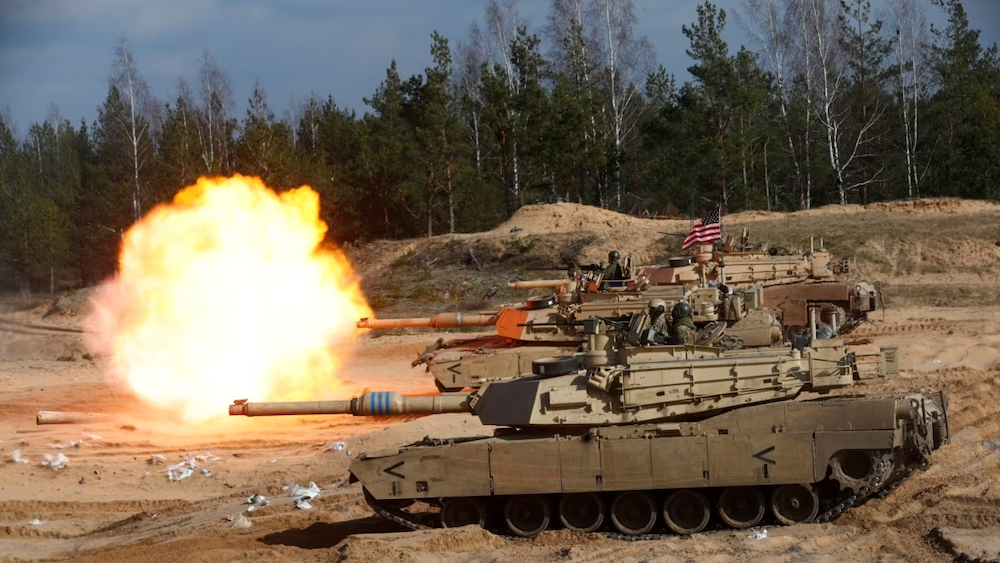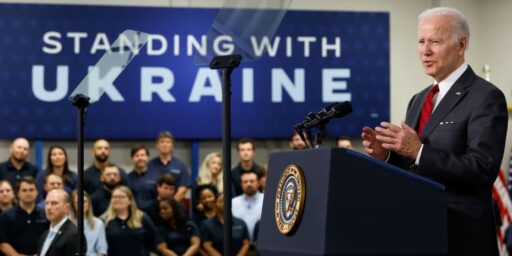U. S. Sending Abrams Tanks After All
An object lesson on the challenges of alliance politics.

After months of resistance, the Biden Administration will send a contingent of M-1 Abrams main battle tanks to Ukraine so that Germany will allow more suitable tanks to be sent.
Defense One Technology Editor Patrick Tucker(“US to Send 31 M1 Abrams Tanks to Ukraine“):
The United States will send Ukraine 31 M1 Abrams tanks—enough to arm a battalion—after training their crews in the months ahead, senior White House and defense officials announced Wednesday.
Combined with promised deliveries of U.S. Bradley Fighting Vehicles and other countries’tanks, light tanks, and other armored vehicles, one senior administration official said, Ukrainian forces will soon receive “hundreds” of armored vehicles of various types.
The announcement came one day after German officials said they would provide 14 German-made Leopard 2 tanks, in coordination with Poland and other allies who will send their own Leopards. Their ultimate goal is to send Ukraine 88 tanks, enough for about two battalions.
A senior defense official told reporters Wednesday, “In the weeks, and really the days leading up to [the announcement], we did hear some major commitments by allies of additional armored vehicles and tanks, including the Challenger [2] tanks from the UK. Certainly, the U.S. and the Netherlands are still working to deliver 90 T-72 tanks, which we had refurbished and about half of those are arriving on the battlefields now. You also have France announcing their Amx-10 [RC] light tanks. And then in the armored vehicle category and the infantry fighting vehicle category, in addition to the U.S. Bradleys–and we’re over 100 at this point–you also have the 40 Marders from Germany. And Sweden also has announced 50 CV90s. And there’s a host of Soviet-era BMPs that were also announced. So you’re going to see hundreds of armored vehicles, exceptionally capable vehicles, and tanks arriving in Ukraine.”
A senior administration official said that discussion between allies on how to help Ukraine has intensified ahead of a possible Russian push to claim territory.
“We do expect that Mr. Putin and the Russian military will try to go on the offense here in coming weeks and months, as the weather gets better,” the official said, adding that the administration aims to help Ukraine “have the ability to retake the to reclaim their sovereign territory. And that means everything that is recognized by international borders,” including Crimea.
The defense official said that the Abrams represent a “long-term commitment.” The United States will provid them through the Ukraine Security Assistance Initiative, or USAI, as opposed to via presidential drawdown authority. That’s important because the USAI, as a funding mechanism, takes more time. But administration officials said that the goal is to enable Ukraine to maintain and use the tanks long-term.
The defense official said, “Because this is a procurement under USAI, we’re talking months as opposed to weeks. And as with other capabilities, you’ve seen us do this before, if we do not have [it] readily within U.S. stocks, then we go the procurement route to make sure that we can procure the right capability for Ukraine. And that is what we’re doing here with the Abrams in terms of sustainment, maintenance, and training.”
The official continued,“We will have the ability to put in place a very careful training program. But also a very careful program to be able to maintain and sustain these tanks, which do require a good deal…of assistance.”
The United States will also send eight M88 recovery vehicles to service the tanks in the field.
Defense One Global Business Editor Marcus Weisgerber (“US Army Readies Ukraine Abrams Tank Options For Policymakers“) adds:
Now that the White House has pledged to send M1 Abrams tanks to Ukraine, the Army is working up various plans to help the Ukrainian military operate the maintenance-hungry and fuel-thirsty battlefield behemoths.
“The Army is developing options that will be presented to senior leaders,” Douglas Bush, the Army’s top acquisition official, said at a Pentagon briefing just hours after President Joe Biden announced the coming transfer of 31 tanks to Ukraine. “I think there are multiple courses of action and it’s not just the tanks. We have to be able to deliver the tanks, the support equipment, the training, the ammunition, the fuel, you know, the total package fielding like we do with other Abrams partners.”
Bush, a West Point graduate who was an Army armor officer, said the Abrams “has a significant logistics aspect to it.” Typically, the U.S. provides training and other related equipment with foreign arms deals so that the weapon remains effective.
“I assume that that will be part of what’s provided,” he said.
Bush said that policymakers will decide the timeline for sending the tanks to Ukraine and that “the Army will make whatever they want to happen, happen.”
The U.S. has not built new Abrams tanks since the early 1990s. With the Cold War over, thousands of Abrams that were built to fight the Soviet Union were put into storage, according to Dean Lockwood, a military vehicle analyst with Forecast International.
These days, defense contractor General Dynamics remanufactures Abrams tank hulls for the U.S. Army and allies in Lima, Ohio. The overhauls produce “essentially a spanking brand-new tank for about half price,” Lockwood said.
Currently, the U.S. has about 8,000 Abrams, but “significantly less” are battle-ready, he said. The U.S. draws from those tanks in storage and remanufactures them for allies, such as Poland, which is buying upwards of 350 Abrams.
General Dynamics executives said Wednesday that the Abrams production line can meet the demand of sending tanks to Ukraine.
“Staffing is not an issue here. There is plenty of capacity on the combat vehicle side [of the company] both tracked and wheeled [vehicles],” CEO Phebe Novakovic said on the company’s quarterly earnings call. “So to the extent that the U.S. government intends to execute any contracts with respect to some of these bilateral agreements they are developing…it’s well within the capacity of the industrial base to accommodate.”
The transfer of U.S. and European main battle tanks to Ukraine marks a shift in the types of weapons transferred by the United States and its allies from standoff defensive weapons to an offensive system on the front lines.
“A tank, by definition, has to be at the very front,” he said.
The U.S. will likely remove classified electronics from the Abrams before shipping them to Ukraine, similar to what it did with a Stinger missile part last year. Yet Lockwood noted that even a somewhat stripped-down Abrams, if captured by Russian forces, could help Moscow look for vulnerabilities or reverse-engineer NATO technology.
“I suspect there are a lot of people in the Army who are not happy about this whatsoever,” he said.
US Defense Department leadership resisted this move for weeks but, ultimately, alliance politics made it the least bad option, as a team of reporters from POLITICO (“Inside Washington’s about-face on sending tanks to Ukraine“) explain:
In the weeks after Volodymyr Zelenskyy’s Christmastime visit to Washington, U.S., German and other European leaders became locked in an increasingly ugly tit-for-tat over whether to send tanks to Ukraine. As language got heated behind the scenes, neither the U.S. nor Germany would budge — even as the standoff exposed a rare breach between two of Kyiv’s biggest backers.
Ultimately, President Joe Biden decided it was more important to show a unified front and send the tanks — a move that could go down as one of the most consequential decisions in the multinational effort to arm Ukraine.
Biden concluded it was important to move in lockstep with an ally, despite the Pentagon’s misgivings, and put an end to the dispute. Backed by some of his top aides, including Defense Secretary Lloyd Austin, Biden early this week agreed to send 31 Abrams main battle tanks to Ukraine. Germany, meanwhile, is sending 14 of its own Leopard tanks to the front line, and gave permission to other countries to re-export their German-made tanks as well, for a total of about 80 Leopards.
Biden “knew the only way Germany would do Leopards is if we did Abrams and allied unity is the most important thing to him. So Secretary Austin sent a proposal on how to make it happen,” one U.S. official said.
The US reluctance was easy to explain: the Leopard is an older design and much easier for a burgeoning army such as Ukraine’s to maintain. Most of its neighbors, including former Warsaw Pact mates like Poland, already use the Leopard and have stockpiles of parts and ammunition. So, why insist on the Abrams being part of the deal? Why not step up and be the main provider of something?
Throughout their talks, German officials felt that the Pentagon was more reluctant than the White House, but there was also a growing awareness that Berlin’s insistence on the American tank was increasingly upsetting U.S. officials, who stressed that Washington was already supplying widespread military support and that it was Berlin’s moment to step up.
Pressure within Europe continued to mount on Germany to make a move. On Jan. 11, Polish Prime Minister Mateusz Morawiecki spoke by phone with French President Emmanuel Macron and discussed how to convince Scholz to drop his resistance on tanks.
Macron suggested he and Morawiecki tag-team Scholz into submission ahead of last Friday’s meeting at Ramstein Air Base. A few days later, Morawiecki traveled to Berlin, where he met with conservative opposition leaders, but not Scholz.
Back in Warsaw on Jan. 18, Morawiecki broke a major diplomatic taboo by threatening to send Ukraine Leopards without waiting for export approval from Germany. Scholz’s chancellery was livid, but officials there knew they were running out of time.
Scholz last week told Biden on a phone call and U.S. lawmakers in Davos that no Leopards would make their way east unless Abrams accompanied them. In Scholz’s mind, the two were inextricably tethered.
Scholz has been adamant in his discussions with Biden that supplying Leopard tanks to Ukraine marks such a qualitatively new step that the U.S., as the world’s biggest military power but also Germany’s guarantee for nuclear deterrence, must be involved.
They also wanted to demonstrate unity toward Putin. “It was important to the chancellor from the very beginning … that we take every step with as much unity as possible,” said Scholz’s spokesperson Steffen Hebestreit.
The allies had for the past year kept a surprisingly enduring unified front on Ukraine, contrary to the assumptions made by many before the conflict started, above Vladimir Putin in Moscow.
But the debate over the Leopard was turning toxic quickly and most of all unusually public. At Davos, the Polish President Andrzej Duda and Lithuania’s Gitanas Nauseda voiced their frustration with Germany and Scholz in private conversations. By then, Scholz was ignoring Duda’s calls to meet together and discuss the next steps on the Leopard. For his part, Scholz returned the hostility from the new eastern allies of NATO. He has been particularly angry with the right-wing Polish government’s sniping at Germany.
After Davos, the hope in Washington and European capitals was that everyone could agree on a path forward during a meeting of 50 countries at Ramstein Air Base in Germany last Friday. There, Ukrainian Defense Minister Oleksii Reznikov gathered with the defense chiefs of 12 European countries who field Leopard tanks, including Germany. But Berlin said it was still mulling it over.
The frustration prompted Polish Foreign Minister Zbigniew Rau to tweet: “Arming Ukraine in order to repel the Russian aggression is not some kind of decision-making exercise. Ukrainian blood is shed for real. This is the price of hesitation over Leopard deliveries. We need action, now.”
While Poland’s emotions are easy to sympathize with, especially given their shared history with Ukraine, it’s not unreasonable that US and German leaders factor in other considerations.
For the US, repelling the Russian invasion is an important military goal but a tertiary one. It checks the “liberal international order” box and serves as a de facto proxy war that is seriously weakening our identified secondary adversary. But, even aside from concerns about the logistics of supplying these to Ukraine, there’s the matter of maintaining readiness in the, frankly unlikely, possibility of a near-term war with China.
For Germany, the prospect of being a leader on national security policy for the first time in the post-WWII era is rather daunting. They’re simply unwilling to take on any significant risk without Washington taking the lead, or at least appearing to do so.
With no deal with Washington in sight, the chancellor was under increasing pressure from his own coalition partners as well as European countries, especially Poland. After the failure to achieve a breakthrough, attempts to rope in the U.S. continued over the weekend, with two men — new German Defense Minister Boris Pistorius, who had only been appointed days before, and Scholz’s powerful right-hand man, chancellery minister Wolfgang Schmidt — playing a key role, two officials said.
Biden was constantly updated by his senior staff on the talks as he heard arguments for and against sending Abrams.
The president knew Ukraine needed Leopards — which are abundant across Europe and easier for the Ukrainians to use and maintain than the Abrams — on the battlefield as soon as possible. He started to lean toward sending the M1s after seeing bipartisan support for the transfer, and realizing the Germans would not budge.
Ultimately, Biden decided to send American tanks after Austin recommended providing 31 M1s, the size of a full Ukrainian army battalion.
The U.S. could have sent just one tank to seal the deal with Germany, but Austin decided to send a full battalion. This shows the decision was “not a symbolic gesture, but something the secretary thought was the right thing to do,” the second official said.
Hours after reports of Biden’s decision emerged, news surfaced that Scholz was ready to approve the Leopards. But not everyone in Germany’s ruling coalition was happy. Anton Hofreiter, a lawmaker from the Green party, one of the coalition partners of Scholz’s Social Democrats, said the chancellor lost time by insisting on the U.S. linkage and antagonized close allies.
“It would have been better for Germany’s international reputation to decide more quickly. In particular, many countries in Europe were annoyed to make the delivery dependent on the United States,” Hofreiter said.
Sure. But that would have required leadership and courage.
After a discussion of the logistical challenges and timeframes laid out in Weisgerber’s report, we get this:
In a Wednesday morning call with Ukrainian Defense Minister Oleksii Reznikov, Austin didn’t give a timeline for when the first Abrams might arrive. The priority for now, he added, should be on training the Ukrainians on Leopard tanks, along with U.S.-supplied Bradley infantry fighting vehicles, and new mobile howitzers and other heavy armor recently announced by Western partners.
In an interview, Ukrainian Prime Minister Denys Shmyhal was far more optimistic about the timeframe.
“We are aware of the fact that training soldiers to operate Abrams tanks takes months. But we are also convinced that the United States have decided to provide Ukrainians with the insight, rapid training program for tank cooperation,” he said. “And this may mean that jointly with the highly motivated Ukrainian fighters, this training might take weeks rather than months.”
Now that the dustup appears to have been settled for now, not everyone is ecstatic at how the whole process played out.
“Germany is still very afraid of Russia. That is the reality,” said Oleksii Goncharenko, a member of Ukraine’s Parliament. “They are still playing these games about defensive weapons versus offensive weapons. It is nonsense because the war is a defensive war for us.”
A senior Polish official said Scholz’s delay was looked at “with embarrassment.” The chancellor “bears full political and moral responsibility for his decisions, and he will be accountable for his decision to voters and history.”
I suspect history will not remember Scholz’s name and that the German voters won’t care one way or the other. Regardless, Ukraine will get its tanks.






Given that we’ve been happy to sell them to countries with far less capable militaries like Iraq, the “they’re just too complicated for the simple Ukrainian mind to handle” line of argument never really held water and was frankly kind of patronizing.
There has been an awful lot of chatter about how long it will take to get the Ukrainians up and running with the tanks, both the Leopards and the Abrams. I may be going n-dimensional chess but I’m wondering if that is a feint and the tanks will be deployed in time for the spring offensive.
What does Stacey need with tanks? She conceded the election.
Here’s the press release:
Notice the difference between Presidential Drawdown Authority and Ukraine Security Assistance Initiative (USAI). PDA draws out of existing stocks and USAI begins a procurement process. So this implies that actual deliveries may be in the distant future.
Biden Administration Announces Additional Security Assistance for Ukraine
The problem with Germany appears to be that Scholz is afraid of the potential consequences of an Ukrainian victory.
His line is (and has been for months): “Ukraine must not lose and Russia must not achieve its aims” – in marked contrast to his foreign secretary Baerbock (who represents the Greens rather than the SDP) who has explicitly and repeatedly expressed her wish for an Ukrainian victory.
Scholz’s preferred outcome appears to be a negotiated settlement. Considering the escalatory risks (and setting aside the moral dimension), this is not entirely crazy were it not for the fact that Russia has left itself no room for negotiations and cannot reasonably expected to keep its word anyway (see, e.g., the Budapest Memorandum).
Also, war is highly contingent and trying to keep Ukraine from winning could easily lead to its defeat. Which would, IMO, be a much riskier outcome. A victorious and emboldened Russia might very well be a much greater threat to global peace than if it were to lose the current war.
Other countries can see the faults in Scholz’s assessment as well. Hence all the (well-deserved) pushback. Which isn’t to say that Germany hasn’t provided A LOT of military assistance, but most of it is “defensive,” e.g., SAMs and radars and such.
During the tank soap opera, I began to wonder if the Abrams’ were such fuel guzzlers and maintenance nightmares, were they a reliable weapon for the US to base its mechanized forces around? To pursue a somewhat tortured analogy, compare the Abrams to a race car, you may have the fastest, most powerful and best handling car in the field, but if it continually breaks down it won’t win many races.
@Sleeping Dog: Those 8 Tactical Vehicles for recovery in the Abrams package are basically tow trucks for tanks.
@drj:
Don’t forget the thousands of helmets… Scholz has been brought to support Ukraine the whole time kicking and screaming that he didn’t want to go there. The Greens have been more forceful in their support for Ukraine than Scholz.
@Scott:
I knew that, which adds evidence to my point.
@MarkedMan:
I’ve been having the same thought, but dismissed it on the grounds that I will always try to write an interesting narrative and reality is generally less compelling.
I’m in favor of this.
It’s time to put an end to Putin’s ongoing war-crime.
Crush the pudgy little fuqer and send him to the Hague.
@Stormy Dragon: I don’t think the argument was that the Ukrainians are too stupid to use them but that it’s really hard to get them trained up and set up the proper infrastructure in the middle of a shooting war. The Aussies and Poles had much more lead-up and, frankly, the possession of most systems by Arab forces are for show, in that they seldom actually operate, much less maintain, their own systems.
@Stormy Dragon:
A couple points on this:
First is the timeframe – Ukraine needs tanks quickly for the current war and for offensive operations (as well as defending from expected Russian offensives) in the Spring. The question isn’t about Ukraine’s ability to learn to operate the tanks, but doing so in a realistic timeframe for a war that is currently in progress. When Iraq contracted for the Abrams, it included, IIRC, a 5 year training period.
Secondly, with Iraq (and most ME allies who have the Abrams, like the Saudi’s), all the logistical and maintenance portions are contracted out. So Iraq only operates the tanks – pretty much everything else is done by General Dynamics or a sub-contractor. Same with the Saudi’s. That won’t really work in Ukraine. And these are complex vehicles that break easily and require trained maintenance and sustainment personnel. Training a tanker who knows T-72’s to operate an Abrams is going to be easier than training all the maintenance personnel on the unique systems in the Abrams, especially the turbine engine. Can it be done? Yes, but it takes time – time Ukraine doesn’t really have.
Third, as part of those contracts with Iraq and Saudi, the relevant logistical and maintenance facilities were built in the country – which took years. No such facilities exist in Europe anymore since the US hasn’t had a permanently stationed armored unit there since 2013. The US units with Abrams that are there now are rotational units that ship out broken tanks with serious maintenance problems for repair.
And regardless, this was a political concession – Abrams tanks will likely not be in Ukraine for months if not longer. The tanks need to be prepared for export, including the removal of uranium armor, which is a US-exclusive feature. And like everything else, that takes time, and General Dynamics can only do that on a few tanks per month.
Have seen several poll results indicating that Scholtz is dead-center in public opinion in Germany, altho have no personal knowledge of the reliability of that little nugget.
Quite a lot of twittering to the effect that Putin has gone to great length & great pains to recreate the Great Patriotic War: German tanks rolling across Ukraine slaughtering Russian diviisions in its path.
I find the Abrams tank a very confusing program to follow. Along with what @Sleeping Dog said above, is the Abrams something we should be basing our heavy forces on if it’s such a maintenance headache? It’s questionable at best that the Abrams is the best tank in the world–in tank challenge war games over the last decade various European tanks have routinely come in first with the Abrams rarely getting into the top 3. Now part of that could be crew and training, or some n-dimensional Pentagon BS about not having top line systems inside the Abrams, or whatever. But…
Given that the Leopard 2’s seem to be routinely at or near the top in tank challenge competitions, AND are easier to supply and maintain, they really should form the backbone of Western tank reinforcements to Ukraine (80? Pff-send a few hundred). And I really wonder why the Abrams and US crews don’t do better in those war-games, require a unique fuel and large logistics tail compared to other forces…
Fortunately Ukraine seems to be doing a fine job wiping out the only real “enemy” we might end up in a tank war with anyways. Tanks won’t play much of a role in fighting off China over Taiwan, and it’s not like we’re at any risk of war with anyone except Russia and China in the next couple decades.
And sorry @Stormy Dragon, no one is saying they are too complicated for simple Ukrainian minds. That’s a silly take on the issues with deploying Abrams to Ukraine, and pointlessly insulting to those with actual and real concerns. Logistics matter, a lot (see, for example, the Russian invasion of Ukraine 😉 ). Abrams are simply more complicated to deploy than pretty much any other MBT in the world for reasons that have nothing to do with the intelligence of the people in question, as @Andy laid out.
A small kvetch against the media generally, although I can’t imagine anyone but I and maybe Kathy care. The M1 does not have “jet” engine. It has a turbine engine, more specifically a turboshaft engine. It produces shaft horsepower, revolutions and torque. A turbojet engine produces thrust by pushing out a jet of hot gas.
Andy is saying exactly what informed people in the UK are. The Abrams is a great package, but you need to master the whole package, not just the tank itself.
Arabian case are a bit like how US and UK support advanced fighters there: almost the whole thing is handled by contractors, who are mostly ex-USAF and RAF types.
That can’t be done in Ukraine, for obvious reasons.
So Abrams will take time to become an effectively sustained force element.
Even Challengers will be challenging (Sorry, but i just couldn’t resist) 🙂
That’s why Leopards are what’s needed; they are by design less support intensive, and there are already support chains and depots in Poland, Slovakia and Romania.
And it is fairly well known on the grapevine that Ukrainian tankers and mechs have been all over the Polish Leopard depots for months. They are pretty much good to go.
Abrams are essentially an armour-plated hijab for Olaf Scholz’s blushing modesty.
Though I suppose they just might come into play by autumn.
@JohnSF:
I suspect as well that Abrams may be less about winning this war, and more about beginning the longer-term process of improving Ukraine’s defense posture and signaling same. Maybe less about 2023 and more about beyond. I’m also hearing talk of F-16s – speaking of extended training times and long logistical tails.
@Michael Reynolds:
And here was me thinking Leopards had quite long tails.
Maybe the French should rename the AMX-10 as le Bobcat 😉
Hah. I should have guessed. Germans and their fondness for pussycat names for armour:
Behold the Lynx!
And if they haven’t sent any, would it be the missing Lynx? 🙂
@gVOR08:
Jets are a type of turbine engine. It’s in the names turbojet and turbofan. At some point, I think shortly after WWII, jet propulsion research made little distinction between turbojets and rockets, as both depended on a jet of hot gases at high speed for thrust.
BTW turbine engines are very old. One of the first was demonstrated in the Turbinia in 1894.
@JohnSF:
It’s tradition. In WWII they had the Tiger and Panther. The US Army names their tanks after army officers, like the Sherman in WWII. As best I can tell, the Soviets just number theirs. At that, the T-34 was one of the mot capable tanks in WWII.
Apparently it derives from the similarity in German between “panzer” which basically means “a coat of armour or mail” and “panther” ie the big cat.
Or so I’ve heard, from an old Royal Tank Regiment guy.
@Kathy:
And IIRC all the British tanks have names starting with “C”because they are descendants of the WW2 “cruiser” line of development.
The other line being the “medium” which came to an end with “Matilda”.
Pity. The “Maud” or the “Margaret”would be good for a laugh.
@Stormy Dragon:
Given the outcomes of US intervention in Iraq, this looks like ‘learning from your mistakes,’ no?
My buddies across Berlin are concerned about Russian aggression and thus frustrated with Scholz, but I’d expect my self-selected sample of friends to share my worldview. I suspect there’s plenty in Deutschland who agree with Scholz’s foot-dragging, and it’s smart to exercise caution re: war and an egomaniac like Putin.
The US tanks aren’t going to do much good for Ukraine in the short term. They’re being sent in part to force Scholz’s hands, obviously. If they allow Ukraine to defend itself better in the future, all the better.
The leopards will be there well before any abrams makes it remotely close to Ukraine. I’m not even sure if the abrams will be there in time for the spring offenses that will inevitably occur. Facilities are busy producing and setting up tanks for Poland and Taiwan right now.
The gas turbine used by the abrams is the Honeywell AGT1500 which can run on a variety of fuels including jet fuel, gasoline, diesel and marine diesel. I’m not sure where people are getting the stuff about the turbine being picky about it’s fuel. It’s actually quieter than diesel based tanks and allows the abrams to be overall more maneuverable than other MBTs. Last I looked the service intervals were actually longer on the turbine vs diesels. Now when maintenance is required the turbine is definitely more troublesome than diesel and it also has a much higher fuel consumption rate.
@Michael Reynolds: You are correct this is about setting Ukraine up for success years from now.
@Kathy: The British were the ones naming US tanks in WW2 due to lend lease.
The t-34 was a pretty awful tank. The transmission basically required a hammer to change gears. The steering was stiff and hard. The crew were cramped and uncomfortable. The gun itself was meh until the 85 was tossed in which made the cramped quarters even worse. The armor was of questionable quality at best. Many of them broke down relatively close to the factory they were made in. Which was kind of fine because often the fight was nearby. Maneuverability was poor etc etc. The tank has been wildly over hyped by casuals. Yes it had slanted armor but that meant that interior crew space was seriously reduced as a result. Sloped armor wasn’t anything new when the t34 was designed. Angling armor to produce a superior effect was already part of doctrine. Overall I’d rank it near the bottom on a list of tanks I’d want to serve in during ww2.
The M4 angled properly has as much effective front armor as a tiger or panther tank.
@Andy: @JohnSF:
A point of curiousity, as I recall the last upgraded version of the M60 MBT was only retired by the USA at end 90s, given the sheer numbers produced I would have thought there could be potential to provide numbers of those. Since not discussed presumably not but surprising…. pity then as they performed robustly against mostly the same models that the Russians are bringing to field in the Ukraine.
Otherwise as an investor in certain complex logistics infra installation, I would certainly say that beyond military, the attention to the ‘logistics train’ and staffing depth for the maintenance is a matter of pragmatic wisdom, not sneering prejudice.
In our investment we often for Africa eschew more advanced installation and tech, despite the theoretical interest – not because we think Africans are drooling sub-humans, but the reality is the supply chain for parts is not there for newest tech and one has to create one’s own technician base which means you have don’t have a deep pool – which is of course a big risk (more so in war situations of course). Simpler earlier generation equipment which has market penetration and/or more aligned with available technical skills is simply pragmatic prudence when one can not afford down-times and off-line
@Lounsbury:
Yep; the supply/support chainalready runs into neighbour countries.
They can be used as interim/complex repair sites, as they are now for the heavy howitzers ans GLMRS. And while doing that, you can have buddy-teams of UAF on site being fully trained to replicate support sites in Ukraine ongoing.
Whereas Abrams don’t have any Europe side infrastructure at all now.
And even Challengers are limited, now BAOR is just a memory; though there is a Brit armour support centre at Sennelager, re-opened 2020.
I suspect those chaps are going to be rather busy in the near future.
@Matt:
The T-34 gets some praise in nearly all WWII histories, but details are scant.
I knew about the sloped armor, and so did everyone else clear back to at least when the Monitor fought the Merrimack (not its real name). The other thing that gets mentioned, is the T-34 used Diesel rather than gasoline. The explanation given is that Diesel burns, but gasoline blows up.
@Kathy: Most tanks ran on diesel in ww2. Gasoline requires very specific circumstances to “blow up” which you can also do with diesel. Gasoline is more flammable though which may cause problems after the hit.
The following link covers everything I mentioned and more in detail with pictures, citations, diagrams, etc.
http://chris-intel-corner.blogspot.com/2012/07/wwii-myths-t-34-best-tank-of-war.html
Here’s the US engineering analysis of the t-34-85 which dunks on it pretty hard.
https://www.scribd.com/document/230672358/ENGINEERING-ANALYSIS-OF-THE-RUSSIAN-T34-85-TANK
The Germans dunked on the t-34 in private. Some Germans in public did talk up the t-34 as being a wonder weapon for various reasons. Some did so to put pressure on Hitler for more funding others used them as excuses for their own failures in the field. You could probably find a hundred different reasons people talked the t-34 up.
EDIT : Meant to mention that the IS series of tanks were named after Joseph STalin.
@Kathy:
IIRC another reason for using diesel was that large quantities were available as a by-product of refining aviation gasoline.
Could also be, though this is just a guess that just popped into my head, that engines and distribution for diesel tanks could “piggy back” on existing production and infrastructure for diesel tractors?
@Matt:
I’m fairly sure all US, and German had petrol engines. British were a mix; IIRC the cruisers used petrol, the “infantry tanks” like “Matilda” used diesel. French also a mix: lighter, petrol, heavier diesel.
@Lounsbury:
I don’t have any idea what happened to the M60’s. They were retired long ago and probably were sold off to other countries or scrapped already.
@JohnSF: I meant to say “Soviet tanks”. My mind was already working on the rest of the comment and I never even noticed my screw up. The entire first paragraph is poorly written but there’s nothing I can do about it right now. In my defense it was around 3am when I typed that post and I was heading to bed.
@Andy: Sold off and the remainders used as training aids until around 2005/6. There’s at least a dozen countries still using them. Taiwan has at least 400 of the M60a3 version. The USA is currently working on supplementing those M60s with M1s.